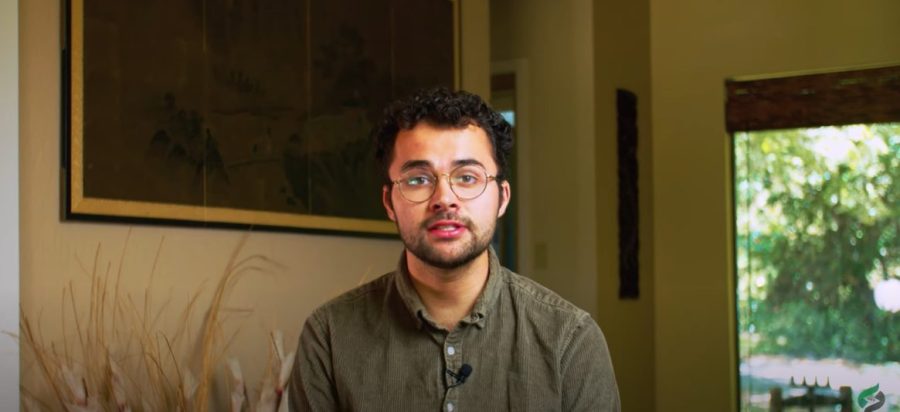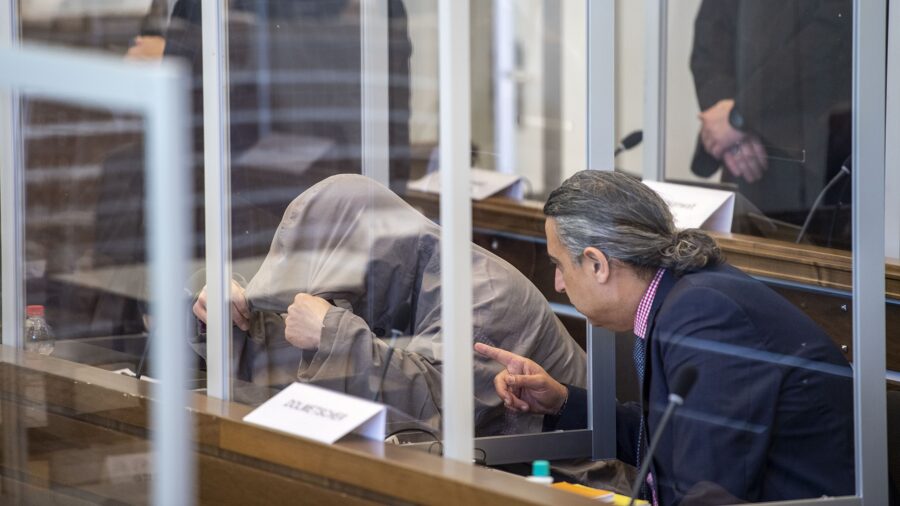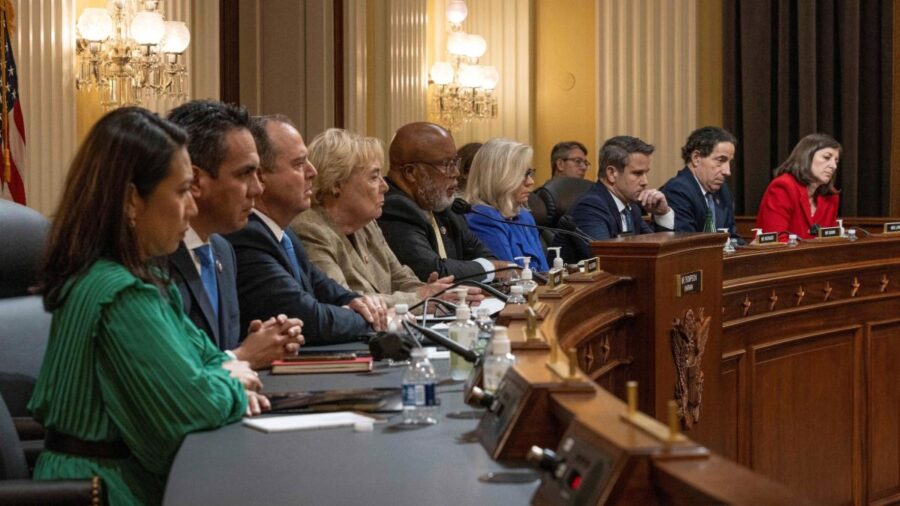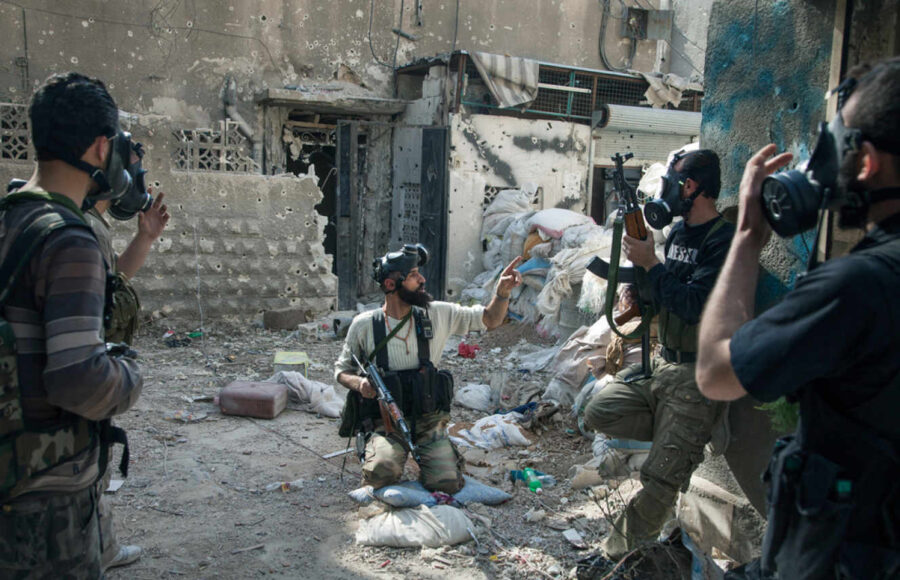Reporters for “Le Monde” spent two months clandestinely in the Damascus area alongside Syrian rebels. On the scene during chemical weapons attacks, they bear witness to the use of toxic arms by the government.
Reporters for Le Monde spent two months clandestinely in the Damascus area alongside Syrian rebels. They describe the extent of the Syrian tragedy, the intensity of the fighting, the humanitarian drama. On the scene during chemical weapons attacks, they bear witness to the use of toxic arms by the government of Bashar al-Assad.
Lire la version française de ce reportage : Syrie : “Le Monde” témoin d’attaques toxiques
Jobar, Syria, by our special correspondent, Jean-Philippe Rémy
A chemical attack on the Jobar front, on the outskirts of the Syrian capital, doesn’t look like anything much at first. It’s not spectacular. Above all, it’s not detectable. And that’s the aim: by the time the rebel fighters of the Free Syrian Army who have penetrated furthest into Damascus understand that they’ve been exposed to chemical products by government forces, it’s too late. No matter which type of gas is used, it has already produced its effects, only a few hundred meters from residential areas of the Syrian capital.
At first, there is only a little sound, a metallic ping, almost a click. And in the confusion of daily combat in Jobar’s Bahra 1 sector, this sound didn’t catch the attention of the fighters of the Tahrir al-Sham (‘Liberation of Syria’) Brigade. ‘We thought it was a mortar that didn’t explode, and no one really paid attention to it,’ said Omar Haidar, chief of operations of the brigade, which holds this forward position less than 500 meters from Abbasid Square.

Searching for words to describe the incongruous sound, he said it was like ‘a Pepsi can that falls to the ground.’ No odor, no smoke, not even a whistle to indicate the release of a toxic gas. And then the symptoms appear. The men cough violently. Their eyes burn, their pupils shrink, their vision blurs. Soon they experience difficulty breathing, sometimes in the extreme; they begin to vomit or lose consciousness. The fighters worst affected need to be evacuated before they suffocate.
Reporters from Le Monde witnessed this on several days in a row in this district, on the outskirts of Damascus, which the rebels entered in January. Since then, Jobar has become a key battleground for both the Free Syrian Army and the government. In two months spent reporting on the outskirts of the Syrian captial, we encountered similar cases across a much larger region. Their gravity, their increasing frequency and the tactic of using such arms shows that what is being released is not just tear gas, which is used on all fronts, but products of a different class that are far more toxic.
In the tangled web of the Jobar front, where enemy lines are so close that the fighters exchange insults as often as they kill each other, gas attacks occurred on a regular basis in April. The gas was not diffused over a broad swath of territory but used occasionally in specific locations by government forces to attack the areas of toughest fighting with the encroaching opposition rebels. This sector is the place where Free Syrian Army groups have penetrated most deeply into Damascus. A merciless war is being waged here.

The sector known as Bahra 1 is one of the most forward positions en route to the sprawling and strategic Abbasid Square, one of the key gateways to Damascus. It was here that fighters commanded by Abu Jihad, known as ‘the Argileh,’ experienced their first such attack on Thursday, April 11. They were taken by surprise. They had heard of gas being used on other fronts, in other regions of Syria (notably Homs and the Aleppo region), over the last few months, but what to do when faced with such an attack? How to protect themselves without abandoning their positions and handing an easy victory to the enemy? ‘Some of the men were evacuated, while others were paralysed with fear,’ one of the fighters said. ‘But we didn’t abandon the position. We ordered the soldiers heading to the front to take wet scarves with them to protect their faces.’
A few gas masks were distributed in the confusion, with priority going to the men in fixed positions where a simple wall sometimes marks the limit of rebel-held territory. Others had to make do with the insignificant protection of surgical masks.
The men under the command of ‘the Argileh’ are not the only ones in the area to have experienced a gas attack. Closer to the nearby meat market, where government tanks are stationed, the ‘special forces’ of Liwa Marawi Al-Ghouta were exposed to concentrations of chemicals that were undoubtedly stronger, judging by their effects on the fighters. We found them in hospitals, struggling for survival, in the hours following the attacks.
In Jobar, the fighters did not desert their positions, but those who stayed on the front lines – with constricted pupils and wheezing breath – were ‘terrorised and trying to calm themselves through prayer,’ admitted Abu Atal, one of the fighters of Tahrir Al-Sham. A man from another brigade, Ibrahim Darwish, died in a nearby sector on April 18.
In the northern part of Jobar, which was struck by a similar attack, General Abu Mohammad Al-Kurdi, commander of the Free Syrian Army’s first division (which groups five brigades), said that his men saw government soldiers leave their positions just before other men ‘wearing chemical protection suits’ surged forward and set ‘little bombs, like mines’ on the ground that began giving off a chemical product. The general asserted that his men had killed three of these technicians. Where are the protection suits seized from the dead? Nobody knows… The soldiers who came under attack that night said there had been a terrible panic, with men fleeing to to the rear. There are no civilians or independent sources to confirm or deny this account: no one is left in Jobar apart from the men fighting on the neighborhood’s various fronts.

But this does not prevent observation of the devastating effects of the gases being used by the Syrian government at the gates of its own capital. On April 13, the day of a chemical attack on a zone of the Jobar front, Le Monde’s photographer was with rebels who have been waging war out of ruined buildings. He saw them start to cough before donning their gas masks, apparently without haste although in fact they were already exposed. Men crouched down, gasping for breath and vomiting. They had to flee the area at once. Le Monde’s photographer suffered blurred vision and and respiratory difficulties for four days. And yet, on that particular day, the heaviest concentrations of gas were used not there but in a nearby area.
Due to the lack of independent witnesses, many doubts have been voiced about the reality of chemical weapons use by government forces, who possess very significant stocks of such arms, and notably neurotoxic gases like sarin. Several countries – the United States, Turkey and Israel – say they have evidence indicating that arms of this type were used, but they have neither disclosed the exact nature of the proof nor decided whether, as President Obama promised in August 2012, the use of such arms by the authorities in Damascus would constitute the crossing of a ‘red line’ that would lead to a foreign intervention in Syria against the regime.
The authorities, meanwhile, have accused the Free Syrian Army of using chemical weapons, only adding to the confusion. To try to determine whether such arms were actually used by the Syrian army on certain fronts, we went to see doctors in the area who are trying to treat or save the lives of fighters exposed to gas. On April 8, at the Al-Fateh de Kafer Battna hospital – the main medical center of the Ghouta region east of Damascus, where a large number of rebels are based – doctors showed us scenes of people suffocating that had been videoed on cell phones. A terrible rattling sound came from a man’s throat. According to medical personnel, the video was shot on March 14 and the man had just been gased in Otaiba, a town east of Ghouta, where since mid-March the Syrian government has been waging a vast operation to surround rebel forces and cut off their main supply route.
One of the doctors, Dr. Hassan O., described these patients’ symptoms in detail. ‘The people who arrive have trouble breathing,’ he said. ‘Their pupils are constricted. Some are vomiting. They’ve lost their hearing, they cannot speak, their respiratory muscles have been inert. If we don’t give them immediate emergency treatment, death ensues.’ This description is identical to those provided by other doctors we met over several weeks in the outskirts of Damascus. With some slight variations: Depending on the area where they came under attack, the fighters say that the chemicals were released by shells, by rockets or by a type of grenade.
On the Jobar front, Free Syrian Army fighters under the command of Omar Haidar say they saw a large cylinder equipped with an opening mechanism hit the ground at their feet when the fifth attack took place, on April 18. The cylinder measured about 20 centimeters, or 5 inches, in length. Was this a chemical weapons device and if so what substance was it giving off? A precise answer would require the kind of investigative protocol that combat conditions have made difficult. Samples must be taken from fighters whose exposure to gas has left them dead or in hospital, and these samples then need to be sent to specialised laboratories abroad. A certain number of such samples have been taken and are being studied.
Since then, gas masks have been distributed in Jobar, along with syringes and doses of atropine, an injectable product that counteracts the neurotoxic effects of sarin. Use of this odorless, colorless neurotoxic gas is suspected by doctors in Ghouta its effects and those observed on the scene are one and the same. According to a well-informed Western source, the Syrian authorities have gone so far as to use mixtures of chemicals, notably with the addition of tear gas, to make it harder to identify the source of the symptoms.

The stakes are high if the use of chemical weapons by the troops of Bashar al-Assad can be proved. Dissimulation is therefore the name of the game. Gas is used on the battlefronts only from time to time, avoiding the kind of massive spread of toxic chemicals that would easily constitute irrefutable proof. Nonetheless, the phenomenon keeps recurring: on Thursday, May 23, according to the rebels, a new chemical attack too place in Adra, a zone of very heavy fighting between government forces and the rebels northeast of Damascus.
In the second half of April, gas attacks became almost a strange kind of routine in Jobar. On the front lines, the rebels of the Free Syrian Army got used to keeping their gas masks beside them. They held regular eye-washing sessions and had syringes ready with a special serum. The aim of the attacks seemed to be essentially tactical at this stage – an attempt to destablise rebel units in areas where government soldiers have been unable to dislodge them, and at the same time a test. If Syrian army forces could dare to use chemical weapons in their own capital without setting off a serious international reaction, would that not be an invitation to pursue the experiment a bit further? So far, cases of the use of gas have not be isolated. The only ophthamologist in the region, who was trained abroad, sees patients in a small hospital in Sabha which he prefers not to identify. He said he had seen 150 people affected by gas in the space of two weeks. Near the zones most exposed to gas, he has organized a system of showers so that rebel fighters exposed to chemical products can wash and change clothes to avoid contaminating health workers at clinics.
Saving the lives of soldiers with the most serious respiratory problems requires carrying them through a long maze of buildings with pierced walls, across trenches and through tunnels dug to avoid enemy snipers, to reach an improvised ambulance parked in a small, inconspicuous space. They must then be driven on a high-speed chase through streets under bullet and shell fire in order to reach a hospital at the front before the fighters die of suffocation.

At the Islamic hospital in Hammuriya, set up in a discreet hangar, the doctor on duty said on April 14 that two hours earlier he had treated a fighter from the Jobar front with major respiratory problems and a heart beat that had ‘gone crazy.’ To save the man, the doctor said, he gave him 15 successive injections of atropine as well as hydrocortisone. Enough to save a horse in a desperate situation.
The night before, one of the ambulances seeking to evacuate men who had been gassed was hit by sniper fire and the driver was wounded. In the morning, ambulances managed to get through by driving at maximum speed under tank fire and reached the front, where a new chemical weapons attack had just taken place. ‘When we arrived, we found everyone lying on the ground,’ said an orderly from another hospital, in Kaffer Batna. He declined to give his name for fear of reprisals against his family, who live in a zone controlled by the government.
That morning, chaos predominated in the courtyard of the hospital, which had been set up in an underground parking lot to avoid being hit by MiG air strikes or government artillery fire. Injured fighters were lying beside five medical workers who had been contaminated by contact with the affected men. More fighters were arriving in successive transfers from the front – there were already 15 of them. Medical workers rushed among the improvised rooms to administer oxygen and injections to the injured.
Dr. Hassan, the hospital’s director, was lying in his tiny office wearing an oxygen mask while aid workers gave him atropine. He had been taking care of emergency cases for an hour when he lost consciousness and began to suffocate. The doctor had been struggling for months to keep things going at his clinic, aided by volunteers, some of them high school students, at a time when a blockade of the region by government forces had made it increasingly difficult for medical supplies to get through. With anaesthesia lacking, field surgeons were reduced to using veterinary products like ketamine. There was no more morphine. The doctor took samples that he managed to send out of the region clandestinely despite myriad difficulties. Their analysis will take a few more weeks before the results are known.
Le Monde’s reporters visited eight medical centers in the eastern part of the Ghouta region and found only two where medical directors said they had not seen fighters or civilians affected by gas attacks. In Nashibiyya, doctors said they had admitted up to 60 cases from the Otaiba front in a single day, March 18. Their modest installation did not have the means to handle this influx, with a lack of oxygen in particular. Five patients died of suffocation. A few days later, recognising the gravity of the situation, the doctors disinterred the bodies of these victims in the presence of local officials and religious leaders and took tissue samples that they tried to send out to a neighboring country. Some of these samples were handed to a small group of fighters who were trying to break through the encirclement of the region by government forces. To this day, the doctors of Nashibiyya don’t know whether the samples ever reached their destination.

A dozen kilometers away, at the hospital in Douma, an area controlled by the Al-Islam brigade, doctors said they had admitted 39 patients after a chemical attack on the town of Adra on March 24. Two men died there. One of the doctors said that within two days of coming under attack, ‘the patients go crazy.’ Marwane, a fighter who was present during the attack on Adra, said that he had seen ‘rockets hit the front and give off an orange light,’ and that while he was being transferred to the hospital he had seen ‘three men die in vehicles on the road.’ In the chaos of the Ghouta region, civilians and fighters often die without reaching a medical center.
Adra, Otaiba and Jobar are three places in the Damascus region where local sources have been describing the use of gas since March. But a difference has emerged: In Jobar, the products have been used more cautiously, with specific localities targeted. Along fronts further from the capital, however, like Adra and Otaiba, the quantities used are estimated to be greater, judging by the number of cases arriving at hospitals simultaneously.
But hospitals in the region are not dealing just with chemical attacks. Two hours before Le Monde’s reporters arrived in Douma, four children who had suffered terrible wounds in a MiG bomb attack were being treated at the hospital’s emergency ward. As soon as their conditions stabilised that had to leave the hospital, with no hope of being evacuated out of Syria. No doubt, like many, they died while en route. Medical workers filmed the children’s wounded bodies, their screams of pain. ‘This, you see, is what happens every day, and for us it’s even worse than the chemical attacks – that’s how bad things have become,’ said a doctor, his eyes haggard. He, too, could not give his name.






